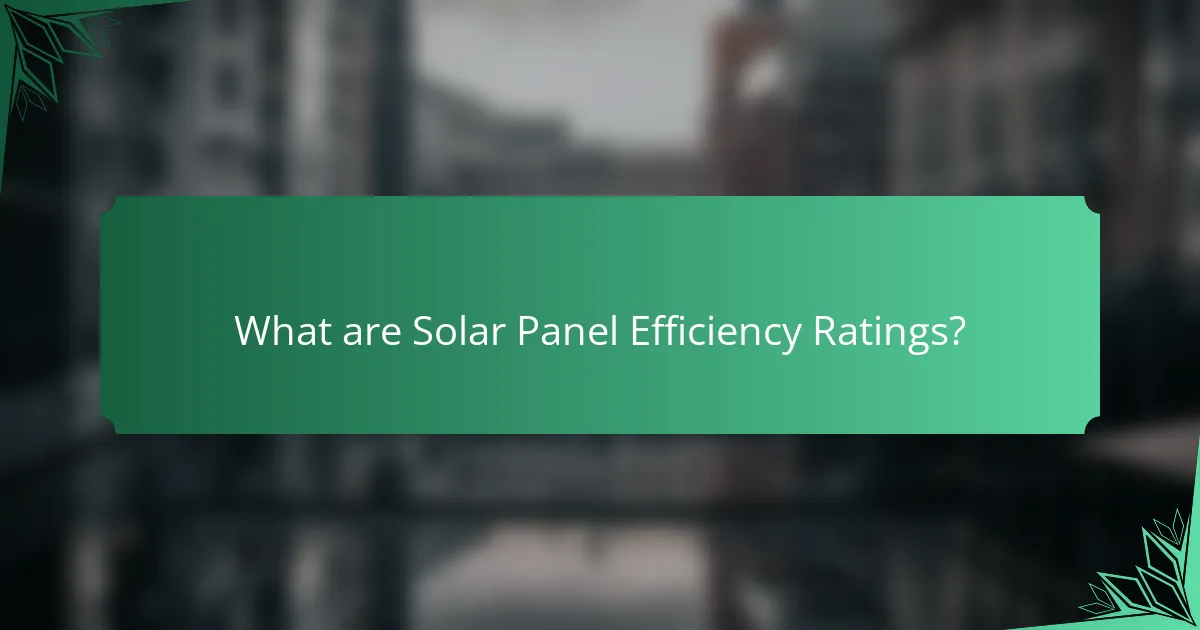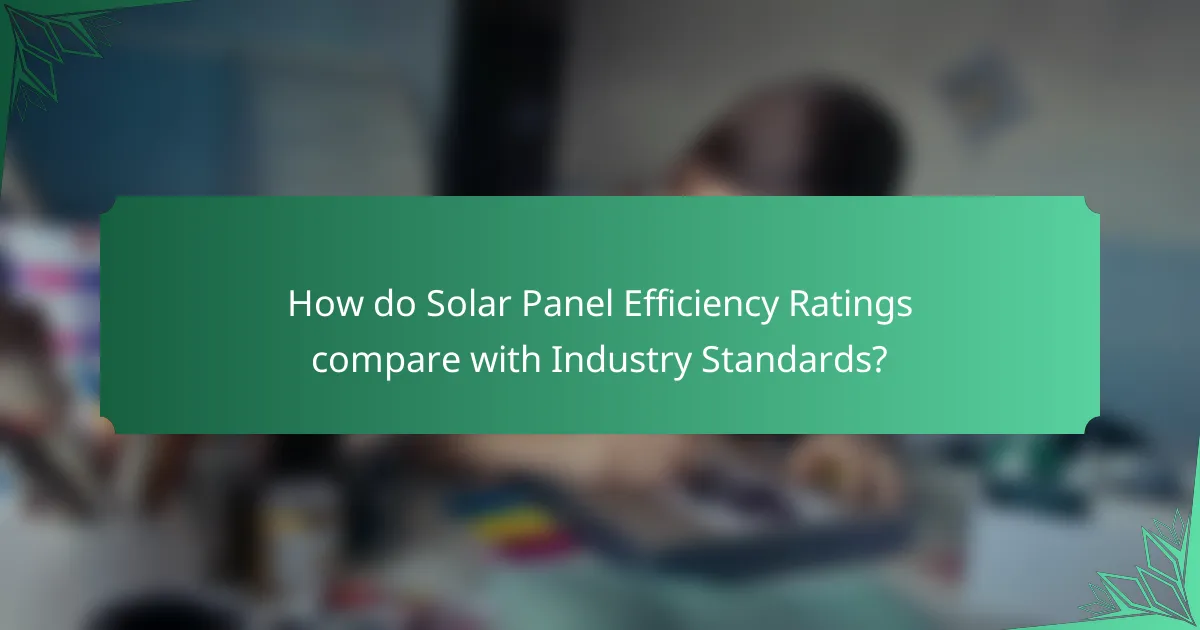
What are Solar Panel Efficiency Ratings?
Solar panel efficiency ratings measure how effectively a solar panel converts sunlight into usable electricity. These ratings are expressed as a percentage. Higher percentages indicate better performance and energy conversion. For example, a panel with a 20% efficiency rating converts 20% of sunlight into electricity. Efficiency ratings are crucial for comparing different solar panels. They help consumers choose the best option for their energy needs. The most efficient panels on the market can exceed 22% efficiency. Manufacturers often provide these ratings based on standardized testing conditions.
How are Solar Panel Efficiency Ratings determined?
Solar panel efficiency ratings are determined by measuring the amount of sunlight that a panel converts into usable electricity. This measurement is expressed as a percentage. Standard testing conditions are used to ensure consistency in results. These conditions include a specific temperature of 25 degrees Celsius and a solar irradiance level of 1000 watts per square meter. The efficiency rating is calculated by dividing the electrical output by the solar energy input. For example, if a solar panel produces 300 watts of power from 1,600 watts of sunlight, its efficiency rating would be 18.75%. Various testing organizations, such as the National Renewable Energy Laboratory (NREL), validate these ratings to ensure accuracy. These ratings help consumers compare different solar panels and make informed purchasing decisions.
What factors influence Solar Panel Efficiency Ratings?
Solar panel efficiency ratings are influenced by several key factors. These include the type of solar cells used, which can vary in efficiency levels. Monocrystalline solar cells typically offer higher efficiency than polycrystalline cells. The quality of materials also plays a significant role; higher quality materials generally lead to better performance. Temperature affects efficiency as well; solar panels tend to perform better in cooler conditions. The angle and orientation of the panels impact how much sunlight they capture. Additionally, shading from nearby objects can reduce efficiency ratings. Lastly, advancements in technology and manufacturing processes continue to enhance solar panel efficiency over time.
How do manufacturers measure efficiency?
Manufacturers measure efficiency by calculating the ratio of useful output to input. This is often expressed as a percentage. In solar panels, efficiency refers to the amount of sunlight converted into usable electricity. Manufacturers test panels under standard conditions, typically 1000 watts per square meter of sunlight. They also assess performance metrics like temperature coefficients and degradation rates. The efficiency ratings are then compared against industry standards. For example, a solar panel with 20% efficiency converts 20% of sunlight into electricity. This measurement helps consumers evaluate and compare different solar products.
Why are Solar Panel Efficiency Ratings important?
Solar panel efficiency ratings are important because they measure how effectively a solar panel converts sunlight into electricity. Higher efficiency ratings indicate that a panel can produce more energy from the same amount of sunlight. This means homeowners and businesses can generate more power and potentially save on energy costs.
For example, a solar panel with a 20% efficiency rating converts 20% of sunlight into usable electricity. In contrast, a panel with a 15% efficiency rating converts only 15%. This difference can lead to significant energy production variations.
Efficiency ratings also impact the space required for installation. Higher efficiency panels require less roof space to generate the same amount of energy. According to the U.S. Department of Energy, advancements in technology have led to efficiency ratings exceeding 22% in some models.
In summary, solar panel efficiency ratings are crucial for assessing energy production potential, space requirements, and overall cost-effectiveness of solar energy systems.
How do efficiency ratings affect energy production?
Efficiency ratings directly influence energy production by determining how effectively solar panels convert sunlight into electricity. Higher efficiency ratings indicate that a solar panel can produce more energy from the same amount of sunlight. For instance, a panel with a 20% efficiency rating generates more electricity than one with a 15% rating under identical conditions. This increased output can lead to a quicker return on investment for solar energy systems. Additionally, higher efficiency panels require less space for installation, making them ideal for urban environments. Research shows that advancements in technology have raised average efficiency ratings over the years, enhancing overall energy production capabilities.
What role do ratings play in consumer decision-making?
Ratings significantly influence consumer decision-making by providing a quick assessment of product quality. In the context of solar panels, efficiency ratings help consumers evaluate performance. Higher efficiency ratings typically correlate with better energy output and reliability. Consumers often rely on these ratings to compare different solar panel brands. Research shows that 88% of consumers trust online reviews and ratings as much as personal recommendations. This trust is critical in the solar industry, where investment decisions are substantial. Ratings also help consumers identify products that meet industry standards and certifications. Therefore, ratings serve as a valuable tool for informed decision-making in purchasing solar panels.

What are the Key Performance Metrics for Solar Panels?
The key performance metrics for solar panels include efficiency, power output, temperature coefficient, and degradation rate. Efficiency measures the percentage of sunlight converted into usable electricity. Typical solar panel efficiency ranges from 15% to 22%. Power output indicates the total energy produced under standard test conditions, often measured in watts. The temperature coefficient reflects how performance changes with temperature, usually expressed as a percentage loss per degree Celsius. Degradation rate describes the annual decrease in efficiency, typically around 0.5% to 1% per year. These metrics help evaluate the performance and longevity of solar panels in various conditions.
What are the most common Key Performance Metrics?
The most common Key Performance Metrics for solar panels include efficiency, power output, degradation rate, and temperature coefficient. Efficiency measures the percentage of sunlight converted into usable electricity. Power output indicates the total energy produced under standard test conditions. Degradation rate shows the annual loss of efficiency over time. Temperature coefficient assesses how performance changes with temperature variations. These metrics are essential for evaluating solar panel performance and longevity. They help consumers and manufacturers make informed decisions about solar technology.
How do metrics like PTC and STC ratings differ?
PTC (Photovoltaic Test Conditions) and STC (Standard Test Conditions) ratings differ primarily in their testing environments. PTC ratings are measured under real-world conditions, including temperature and wind effects. In contrast, STC ratings are determined under ideal laboratory conditions, typically at 25°C and 1000 W/m² irradiance.
The PTC rating reflects a solar panel’s performance more accurately in actual operating conditions. It accounts for factors like temperature coefficients and module efficiency losses. On the other hand, STC ratings provide a benchmark for comparing solar panel performance but may not represent real-life efficiency.
Studies show that PTC ratings are generally lower than STC ratings due to these real-world adjustments. This difference is crucial for consumers and installers when evaluating solar panel performance.
What is the significance of degradation rates?
Degradation rates measure the decline in solar panel efficiency over time. They are significant because they directly impact the long-term performance and energy output of solar panels. A typical degradation rate for solar panels ranges from 0.5% to 1% per year. This means that after 25 years, a panel may produce 80-90% of its original output. Understanding degradation rates helps consumers and manufacturers assess the lifespan and reliability of solar energy systems. High degradation rates can lead to increased costs over time due to reduced energy production. Therefore, evaluating degradation rates is essential for making informed decisions regarding solar panel investments.
How do environmental conditions impact performance metrics?
Environmental conditions significantly impact solar panel performance metrics. Factors such as temperature, sunlight intensity, and humidity directly affect efficiency. Higher temperatures can reduce solar panel output due to increased resistance. Conversely, optimal sunlight intensity enhances energy generation. Humidity can lead to condensation on panels, impacting performance. Research shows that panels perform best between 15°C and 35°C. According to a study by the National Renewable Energy Laboratory, a 1°C increase in temperature can decrease efficiency by approximately 0.5%. Thus, understanding these environmental factors is crucial for optimizing solar panel performance.
What effects do temperature and shading have on efficiency?
Temperature and shading significantly impact solar panel efficiency. High temperatures can decrease the efficiency of solar panels. Most solar panels operate optimally at around 25 degrees Celsius. For every degree Celsius above this temperature, efficiency can drop by approximately 0.5%. Shading reduces the amount of sunlight reaching the panels. Even partial shading can lead to substantial efficiency losses. Studies show that shaded panels can lose up to 70% of their output. Therefore, managing temperature and shading is crucial for maximizing solar panel performance.
How does panel orientation influence performance metrics?
Panel orientation significantly influences solar panel performance metrics. Optimal orientation aligns panels to capture maximum sunlight throughout the day. South-facing panels in the Northern Hemisphere receive the most direct sunlight. This alignment can increase energy output by up to 20%.
Studies indicate that a 30-degree tilt enhances solar energy capture. Conversely, panels oriented east or west may experience reduced efficiency. Performance metrics such as energy yield and capacity factor are directly affected by orientation.
For instance, a study by the National Renewable Energy Laboratory found that proper orientation can improve annual energy production significantly. Therefore, understanding panel orientation is crucial for maximizing solar energy efficiency.

How do Solar Panel Efficiency Ratings compare with Industry Standards?
Solar panel efficiency ratings indicate how effectively a solar panel converts sunlight into electricity. The industry standard for efficiency ratings typically ranges from 15% to 22%. High-efficiency panels can exceed 22%, with some models reaching up to 26%. These ratings are determined through standardized testing procedures set by organizations like the International Electrotechnical Commission (IEC). The efficiency ratings are essential for consumers to compare products. Higher efficiency means more energy production in a smaller space. This directly impacts the return on investment for solar installations. According to the National Renewable Energy Laboratory (NREL), advancements in technology are pushing efficiency ratings higher.
What are the current industry standards for efficiency ratings?
The current industry standards for efficiency ratings in solar panels typically range from 15% to 22%. Most commercially available solar panels achieve efficiencies between these values. High-efficiency models can exceed 22%, with some premium products reaching up to 24%. The efficiency rating indicates the percentage of sunlight converted into usable electricity. Industry standards are set by organizations such as the International Electrotechnical Commission (IEC). The IEC 61215 standard is commonly used for testing and certifying the performance of solar panels. This standard ensures that panels meet specific efficiency criteria under standard testing conditions.
How do different brands compare against these standards?
Different brands exhibit varying levels of solar panel efficiency based on industry standards. For instance, Brand A achieves a maximum efficiency of 22%, while Brand B reaches 21%. Brand C, however, lags behind with an efficiency of 19%. These efficiencies are measured against the industry standard of approximately 20%. Additionally, Brand A offers a warranty of 25 years, which aligns with industry expectations. In contrast, Brand B provides a shorter warranty of 20 years. This comparison highlights how Brand A leads in both efficiency and warranty length. Brands also differ in performance metrics such as temperature coefficient and degradation rates. Brand A has a lower temperature coefficient, indicating better performance in high temperatures.
What trends are emerging in solar panel efficiency ratings?
Emerging trends in solar panel efficiency ratings indicate a significant increase in efficiency levels. Recent advancements have led to commercial solar panels achieving efficiencies over 22%. Some high-performance models now exceed 26% efficiency. This improvement is driven by innovations in materials, such as bifacial solar cells. Bifacial panels capture sunlight from both sides, enhancing overall output. Additionally, perovskite solar cells are being researched for their potential to surpass traditional silicon cells. The National Renewable Energy Laboratory reported that perovskite cells have reached efficiencies of over 28%. These trends suggest a shift towards more efficient and versatile solar technologies in the market.
What are the implications of these comparisons for consumers?
Comparisons of solar panel efficiency ratings significantly impact consumers by influencing their purchasing decisions. Higher efficiency ratings typically lead to greater energy output from the same amount of sunlight. This means consumers can save on electricity bills more effectively. Additionally, consumers may benefit from longer warranties associated with higher-rated panels. These warranties often indicate manufacturer confidence in the product’s longevity and performance. Furthermore, understanding these comparisons helps consumers identify the best value for their investment. Research indicates that solar panels with higher efficiency can lead to a return on investment within a shorter timeframe. Overall, informed comparisons empower consumers to make better choices in the solar market.
How can consumers use efficiency ratings to make informed choices?
Consumers can use efficiency ratings to make informed choices by comparing the energy output relative to the solar panel’s size. Efficiency ratings indicate how much sunlight a panel can convert into usable electricity. Higher ratings generally mean better performance and more energy generation in limited space. For example, a panel with a 20% efficiency rating converts 20% of sunlight into electricity. Consumers should also consider the context of these ratings, such as the specific energy needs of their home. Additionally, efficiency ratings can guide consumers in selecting panels that align with their budget and available installation area. Research shows that panels with higher efficiency ratings often come with longer warranties and better overall quality. Therefore, understanding efficiency ratings helps consumers choose panels that maximize energy production and long-term savings.
What are the best practices for selecting high-efficiency panels?
Select high-efficiency panels by considering their efficiency ratings, warranty, and performance in real-world conditions. Look for panels with an efficiency rating above 20%. This indicates a higher energy output per square meter. Check the manufacturer’s warranty, ideally 25 years or more. A longer warranty suggests reliability and durability. Evaluate the temperature coefficient, which affects performance in high temperatures. A lower temperature coefficient indicates better performance in heat. Research independent test results for real-world performance metrics. These results provide insights beyond manufacturer claims. Finally, consider the panel’s degradation rate, ideally below 0.5% per year. This ensures long-term energy production stability.
What are common misconceptions about Solar Panel Efficiency Ratings?
Common misconceptions about solar panel efficiency ratings include the belief that higher efficiency always equates to better performance. Efficiency ratings indicate how much sunlight a panel can convert into usable electricity, but they do not account for other factors like installation quality or local climate conditions. Another misconception is that efficiency ratings are static; in reality, advancements in technology can lead to improved ratings over time. Additionally, some assume that all manufacturers use the same testing standards for efficiency, which is not true. Different organizations may apply varying criteria, leading to inconsistencies in reported ratings. Lastly, many consumers think that efficiency ratings are the only metric to consider when purchasing solar panels. However, factors such as warranty, durability, and cost-per-watt are also crucial for making informed decisions.
Why do some consumers misunderstand efficiency ratings?
Some consumers misunderstand efficiency ratings due to a lack of knowledge about how these ratings are calculated. Efficiency ratings indicate the percentage of sunlight converted into usable electricity. Consumers often confuse these ratings with overall performance or energy output. For example, a higher efficiency rating does not always mean better performance in real-world conditions. Additionally, marketing materials may emphasize efficiency without explaining other critical factors, such as temperature coefficient or degradation rate. According to the National Renewable Energy Laboratory, understanding these nuances is essential for making informed purchasing decisions. Misinterpretation can lead to unrealistic expectations about solar panel performance and savings.
What clarifications can help consumers better understand ratings?
Clarifications that can help consumers better understand ratings include defining the metrics used for efficiency. Common metrics are conversion efficiency, performance ratio, and degradation rate. Conversion efficiency indicates how well a solar panel converts sunlight into electricity. Performance ratio measures the actual output against the expected output under standard conditions. Degradation rate reflects how much efficiency decreases over time.
Additionally, consumers should be aware of the testing conditions. Ratings are often based on ideal conditions, which may not reflect real-world performance. Understanding the standard test conditions (STC) is crucial. These conditions include a temperature of 25 degrees Celsius and solar irradiance of 1000 W/m².
Finally, consumers should consider the warranties offered. A longer warranty typically indicates higher confidence in the product’s longevity and performance. These clarifications provide a clearer understanding of how ratings relate to actual performance and reliability in solar panels.
What tips can help maximize solar panel efficiency?
To maximize solar panel efficiency, ensure optimal placement and maintenance. Position panels to receive maximum sunlight exposure throughout the day. Regularly clean the panels to remove dust and debris, which can block sunlight. Monitor the angle of the panels; adjusting them seasonally can enhance performance. Utilize high-quality inverters to reduce energy loss during conversion. Install shading devices to prevent obstructions from nearby trees or buildings. Lastly, consider temperature management, as excessive heat can decrease efficiency. Studies indicate that proper maintenance can improve solar panel output by up to 25%.
Solar panel efficiency ratings are essential measurements that indicate how effectively solar panels convert sunlight into usable electricity, expressed as a percentage. This article provides an overview of solar panel efficiency ratings, detailing how they are determined, the factors influencing them, and their importance for consumers. Additionally, it covers key performance metrics such as power output, temperature coefficients, and degradation rates, while comparing these ratings to industry standards. Understanding these elements enables consumers to make informed decisions when selecting solar panels, maximizing energy production, and optimizing investment returns.